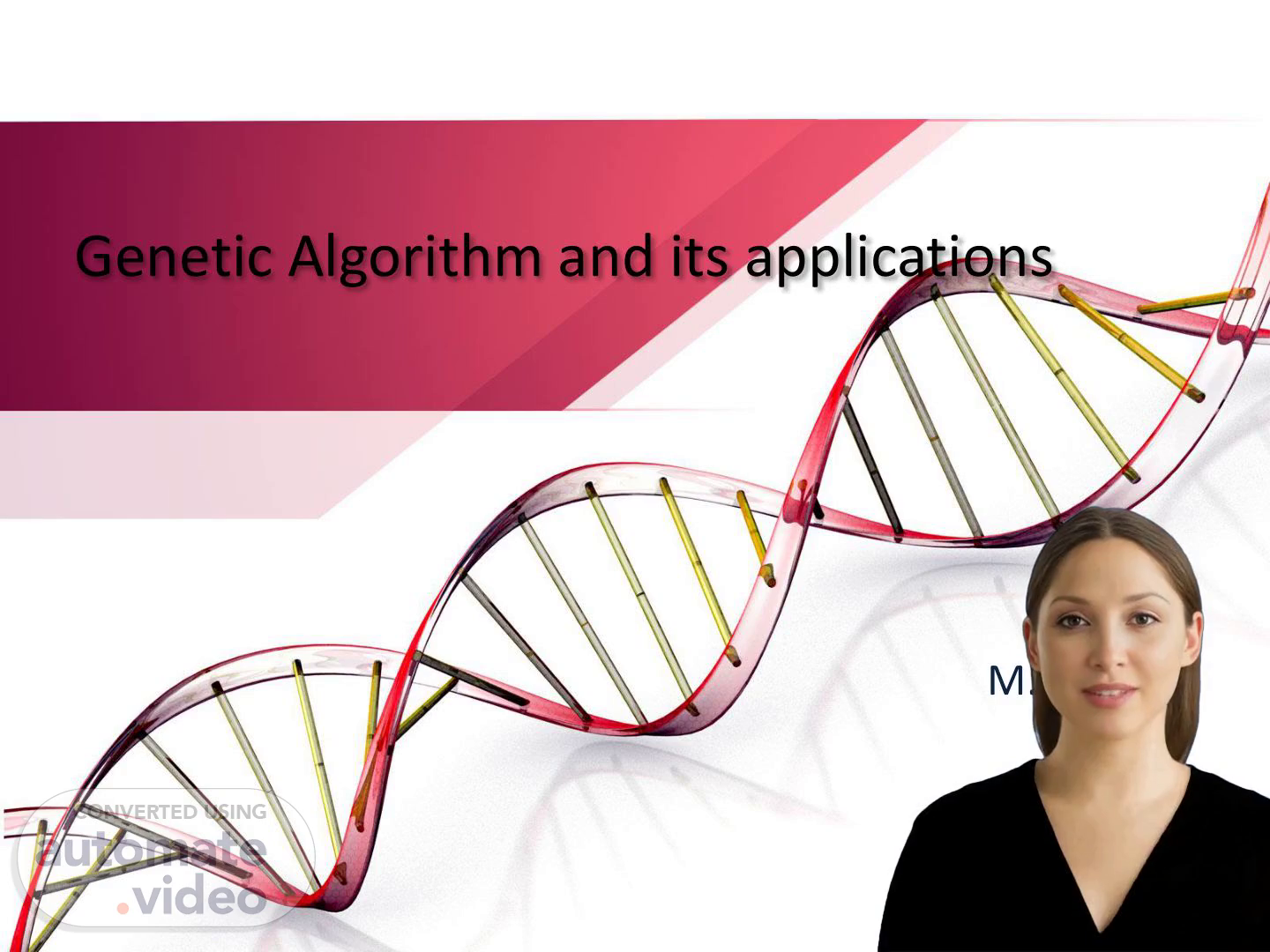Scene 1 (0s)
[Virtual Presenter] Genetic algorithms are a powerful optimization technique that can be used to solve complex problems in various fields. We will explore how they work and their applications in different areas..
Scene 2 (13s)
[Audio] Inspired by Charles Darwin's Theory of Evolution and Natural Selection, the Genetic Algorithm is based on the concept of "Survival of the Fittest". This idea is rooted in the natural world where species adapt and evolve over generations to better suit their environments. Similarly, the Genetic Algorithm adapts and evolves solutions through a process of selection, crossover, and mutation, ultimately leading to improved fitness..
Scene 3 (38s)
[Audio] The Genetic Algorithm is an evolutionary algorithm that can be used for search and optimization problems. These improvements are made iteratively until an optimal solution is reached..
Scene 4 (49s)
Steps in Genetic Algorithm.
Scene 5 (55s)
[Audio] The first step in our genetic algorithm is initialization. In this step, we create a set of potential solutions to our problem. These solutions are often represented by a string of binary digits, but they could also be numbers, words, or any other type of data. We must ensure that these initial solutions are diverse enough to cover the entire search space..
Scene 6 (1m 19s)
[Audio] In this stage of the genetic algorithm, we select the fittest chromosomes from the initial population. This is done if the solution provided by the initial population is not satisfactory according to the fitness function. The goal is to identify the most suitable chromosomes to generate offspring, which will then undergo further evolution. These chromosomes are essentially one of the many possible solutions within the population..
Scene 7 (1m 43s)
[Audio] The genetic algorithm follows a specific set of steps to evolve better solutions over time. One crucial part of this process is selecting the next generation of solutions. Several methods are used for this purpose, including roulette wheel selection, rank selection, steady state selection, tournament selection, and elitism selection..
Scene 8 (2m 1s)
[Audio] In genetic algorithms, crossover is another key operation that helps create new offspring. This process is also known as reproduction. When two parent chromosomes are selected, their genes are combined to form a new chromosome, called an offspring. The genes from each parent are mixed together to create a unique combination. There are different methods to perform crossover, including single point crossover, k-point crossover, and uniform crossover. These methods vary in how they combine the genes from the parents. Single point crossover involves selecting a random point on one parent's chromosome and swapping it with a corresponding section on the other parent's chromosome. K-point crossover involves selecting multiple points on the chromosomes and swapping sections between them. Uniform crossover randomly selects bits from each parent and combines them to form the offspring..
Scene 9 (2m 53s)
Steps in Genetic Algorithm.
Scene 10 (2m 59s)
[Audio] Mutation plays a crucial role in genetic algorithms by ensuring diversity among offspring. This process involves changing bits randomly within chromosomes, which allows for the creation of unique and varied solutions. By doing so, mutation prevents the reproduction of identical offspring, thereby promoting the exploration of new possibilities..
Scene 11 (3m 21s)
[Audio] The genetic algorithm has several advantages. It improves over time, meaning that the more times we run the algorithm, the better it becomes at finding the optimal solution. It does not rely on derivatives, but instead uses the objective function itself, making it easier to use in situations where the derivative information is not available. The algorithm is inherently parallel, allowing it to take advantage of multiple processing units to speed up the computation. Moreover, it can handle multi-objective problems, which is useful when there are multiple conflicting objectives that need to be optimized. However, the genetic algorithm also has some disadvantages. It is computationally expensive, requiring significant computational resources to run. Additionally, it is stochastic in nature, which means that it can take a long time to converge to the optimal solution due to its reliance on random sampling to generate new solutions..
Scene 12 (4m 16s)
[Audio] The applications of Genetic Algorithms include traffic and shipment routing, where it can derive the optimal path from one place to another over iterations. Additionally, it has been applied to image processing, particularly in image segmentation. Furthermore, Genetic Algorithm can be used to find the best fit set of parameters of a neural network. Moreover, it can also be applied to data clustering and mining, where it can find an optimal data center to cluster in..
Scene 13 (4m 43s)
[Audio] Genetic algorithms have various practical applications beyond optimization problems. They are used in feature selection for machine learning models, identifying the most relevant features from a large dataset, which makes it easier to train accurate models. Additionally, genetic algorithms are applied in robotics, enabling the creation of learning robots that can perform complex tasks like cooking. Furthermore, they are used in mechanical engineering design, optimizing the design of an aircraft, for instance, to ensure it is more efficient and cost-effective..
Scene 14 (5m 16s)
[Audio] Genetic algorithms have been applied in medical science to predictive analysis, particularly in protein prediction. This enables researchers to identify potential therapeutic targets and develop new treatments. Similarly, in manufacturing systems, genetic algorithms have been used to optimize production costs, allowing companies to streamline their operations and reduce expenses. Furthermore, in financial markets, genetic algorithms have been employed to find the optimal set of parameters that influence trading decisions, thereby assisting investors in making more informed choices..
Scene 15 (5m 53s)
[Audio] Genetic algorithms are explored through the provided references, offering valuable insights into their workings and applications. These resources enable us to comprehend how genetic algorithms operate and where they are utilized. Their applications span various industries, including optimizing machine learning models and resolving complex engineering issues. This understanding allows us to recognize the potential of genetic algorithms in practical situations..
Scene 16 (6m 21s)
THANK YOU.
